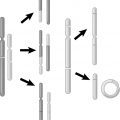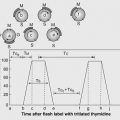16
RADIATION SENSITIZERS, RADIOPROTECTORS, AND BIOREDUCTIVE DRUGS
ADITYA JULOORI AND MICHAEL A. WELLER
Question 1
What is the mechanism by which antiangiogenesis agents increase radiosensitivity?
Question 3
Gemcitabine is a chemotherapy drug that is a well-known radiosensitizer. What is the mechanism by which this occurs?
Question 1 What is the mechanism by which antiangiogenesis agents increase radiosensitivity?
Answer 1
Tumor angiogenesis is characterized by abnormal blood vessels—with irregular shape and high permeability—thus impairing the ability for oxygen to be delivered to the tumor. It is well understood that oxygen is a radiosensitizer. Thus, use of antiangiogenesis agents normalizes the vasculature of the tumor environment, increasing oxygen delivery to the tumor and thereby improving radiosensitivity.
Jain RK. Antiangiogenic therapy for cancer: current and emerging concepts. Oncology. 2005;19(4 suppl 3):7–16.
Jain RK. Normalization of tumor vasculature: an emerging concept in antiangiogenic therapy. Science. 2005;307:58–62.
Question 3 Gemcitabine is a chemotherapy drug that is a well-known radiosensitizer. What is the mechanism by which this occurs?
Answer 3
Gemcitabine is a nucleoside analog that interferes with DNA replication. Ribonucleotide reductase is an enzyme that plays an important role in DNA synthesis and serves to catalyze the production of deoxyribonucleotides from ribonucleotides. Gemcitabine is metabolized to 5′-diphosphate (dFdCDP), which interferes with the normal function of ribonucleotide reductase; by this process, it is believed gemcitabine acts as a radiosensitizer.
Pereira S, Fernandes PA, Ramos MJ. Mechanism for ribonucleotide reductase inactivation by the anticancer drug gemcitabine. J Comput Chem. 2004;25(10):1286–1294.
Shewach DS, Lawrence TS. Antimetabolite radiosensitizers. J Clin Oncol. 2007;25:4043–4050.
Question 5
What are the common side effects of amifostine?
Question 7
What did the Danish Head and Neck Cancer Study (DAHANCA) trial of nimorazole demonstrate?
Question 5 What are the common side effects of amifostine?
Answer 5
Nausea, emesis, hypotension, and allergic reactions are the most common side effects.
Gu J, Zhu S, Li X, Wu H, Li Y, Hua F. Effect of amifostine in head and neck cancer patients treated with radiotherapy: a systematic review and meta-analysis based on randomized controlled trials. PLoS One. May 2014;9(5):e95968.
Stay updated, free articles. Join our Telegram channel

Full access? Get Clinical Tree






